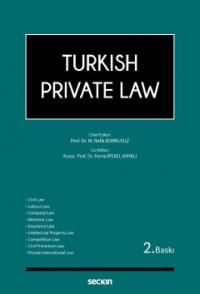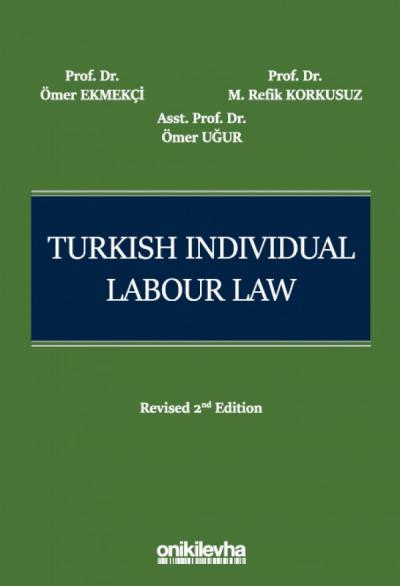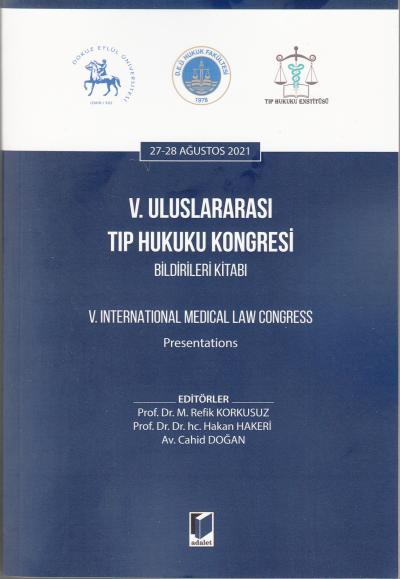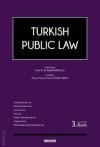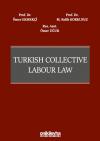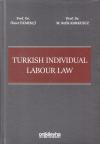Turkish Private Law
Prof. Dr. M. Refik KORKUSUZ
| - | Civil Law |
| - | Labour Law |
| - | Company Law |
| - | Maritime Law |
| - | Insurance Law |
| - | Intellectual Property Law |
| - | Competition Law |
| - | Civil Procedure Law |
İÇİNDEKİLER
LIST OF CONTRIBUTORS
Chapter 1
TURKISH CIVIL LAW
Prof. Dr. Ümit GEZDER Res. Asst. Yasin BÜYÜK Res. Asst. M. Hasanali AKAY Res. Asst. Melike ERGÜN 37
Chapter 2
TURKISH PROPERTY LAW
Prof. Dr. Ümit GEZDER 59
Chapter 3
SELECTED CONTRACTS IN TURKISH LAW OF OBLIGATIONS
Res. Asst. Hasanali AKAY Res. Asst. Murat UÇAK 79
Chapter 4
TURKISH INDIVIDUAL LABOUR LAW
Prof. Dr. M. Refik KORKUSUZ Res. Asst. Ömer UĞUR 111
Chapter 5
TURKISH COLLECTIVE LABOUR LAW
Prof. Dr. M. Refik KORKUSUZ Res. Asst. Muhammed İsmail ÇEKİÇ Res. Asst. Didem YALÇINTAŞ 139
Chapter 6
TURKISH SOCIAL SECURITY LAW
Prof. Dr. M. Refik KORKUSUZ Res. Asst. Ebru KARABACAK 161
Chapter 7
TURKISH LAW ON OCCUPATIONAL HEALTH AND SAFETY
Prof. Dr. M. Refik KORKUSUZ Asst. Prof. Dr. M. Halit KORKUSUZ 209
Chapter 8
TURKISH LAW OF COMMERCIAL ENTERPRISE
Res. Asst. Emin ÇAMURCU 223
Chapter 9
TURKISH COMPANY LAW
Assoc. Prof. Dr. Ferna İPEKEL KAYALI 239
Chapter 10
TURKISH LAW OF NEGOTIABLE INSTRUMENTS
Res. Asst. Hasan Onur AKAY 261
Chapter 11
TURKISH MARITIME LAW
Assoc. Prof. Dr. Hacı KARA 279
Chapter 12
TURKISH INSURANCE LAW
Res. Asst. Sena YAZICI 347
Chapter 13
TURKISH INTELLECTUAL PROPERTY LAW
Asst. Prof. Dr. Özgür ARIKAN 365
Chapter 14
TURKISH COMPETITION LAW
Assoc. Prof. Dr. Ferna İPEKEL KAYALI 385
Chapter 15
TURKISH CIVIL PROCEDURE LAW
Res. Asst. Dr. Elif Irmak BÜYÜK 411
Chapter 16
TURKISH EXECUTION LAW
Nefise Gökçen GÜRCAN Res. Asst. Çağatay Serdar ŞAHİN 445
Chapter 17
TURKISH BANKRUPTCY LAW
Res. Asst. Mehmet Akif GÜL 463
TABLE OF CONTENTS
FOREWORD 5
LIST OF CONTRIBUTORS 7
TABLE OF CONTENTS 11
Chapter 1
TURKISH CIVIL LAW
Prof. Dr. Ümit GEZDER Res. Asst. Yasin BÜYÜK Res. Asst. M. Hasanali AKAY Res. Asst. Melike ERGÜN 37
I. History 37
II. Introduction 38
III. Law of Persons 38
A. Beginning and End of Personality: 39
B. Ability to be Subject of the Rights and Obligations: 39
C. Capacity to Act: 40
1. Full Capacity (Art. 9–13 TCC) 40
2. Full Incapacity (Art. 15 TCC) 41
3. Limited Capacity (Art. 16 TCC) 41
IV. Family Law 42
A. Engagement 42
B. Marriage 42
1. Formalities of Marriage 43
2. Marriage Impediments (Art. 129–133 TCC) 43
C. Divorce 44
V. Law of Succession 45
A. Forced Heirs 46
1. Wills and Testamentary Contracts 46
VI. Turkish Obligation Law – General Provisions 47
A. Contracts 47
1. Capacity to Contract 48
2. Formation of the Contract 48
3. Conditions of Validity 49
a. Immorality 49
b. Public Order 49
c. Imperative Rules 49
d. Personal Rights 50
e. Impossibility 50
4. Form of the Contract 50
5. Genuineness of Assent 51
a. Mistake 51
b. Fraud 52
c. Coercion 52
B. Torts 52
1. General 52
2. Conditions 52
3. Compensation 53
C. Unjust Enrichment 53
VII. Special Provisions 53
A. Classification of Contracts That Are Regulated By Special Provisions 54
1. Classification of contracts by their subject and purpose. 54
a. Sales Contracts 54
b. Barter 54
c. Donation Contracts 54
d. Other types of contracts 54
i. Rental Contract 54
ii. Contract of Loan of an Object for Use and Contract of Loan of an Object for Consume 55
e. Contract of bailment 55
f. Contracts of guarantee 55
2. Contracts that are not regulated in the Code 55
a. Combined Contracts 55
b. Mixed Contracts 55
Bibliography 56
Chapter 2
TURKISH PROPERTY LAW
Prof. Dr. Ümit GEZDER 59
I. Generally 59
A. Property right 59
II. Immovable Property 59
III. Real Rights (Rights in Rem) 60
A. Limited rights in rem 60
1. Servitudes 60
2. Real burdens 60
a. Lien 60
b. Mortgage 61
IV. Possession 61
V. Land Register 61
A. Generally 61
B. The role of registration in the transfer of title 61
1. Introduction 61
2. Relevant Turkish rules 62
3. The publicity principle and the registration principle 63
a. The Absolute Registration Principle (absolutes Eintragungsprinzip) 64
(1) Generally 64
(2) Nature and meaning of this principle 66
(3) The reason for the absolute registration principle 66
(4) Transfer of ownership of real estate through land registration
(the field of application of the absolute registration principle) 66
(a) Generally 66
(b) Elements of the transfer 67
b. The relative registration principle (relative Eintragungsprinzips) 74
4. Conclusion 74
Bibliography 76
Chapter 3
SELECTED CONTRACTS IN TURKISH LAW OF OBLIGATIONS
Res. Asst. Hasanali AKAY Res. Asst. Murat UÇAK 79
SECTION I CONTRACT FOR WORK AND SERVICES 79
I. General 79
II. Definition 79
III. Obligations of the Contractor 80
A. Duty of Care 80
B. Duty of Loyalty 81
C. Obligation Regarding the Material 81
D. Commencement of the Work and Performance of the Work Related with the Contract 82
E. Liability for Defect 83
IV. Obligations of the Customer 84
A. Payment 84
1. Due Date for Payment 84
2. Lump Sum Price 84
3. Price Ad Valorem 85
V. Termination of the Contract 85
A. Exceeding the Approximate Price (Art. 482 CO) 85
B. Destruction of the Work (Art. 483 CO) 86
C. Withdrawal in Return for Indemnity (Art. 484 CO) 86
D. Impossibility of the Performance of the Work Because of the Customer
(Art. 485 CO) 86
E. DeathIncapacity of the Contractor (Art. 486 CO) 87
SECTION II GENERAL EMPLOYMENT CONTRACTS 87
I. Definition 87
II. Elements of the Employment Contract 87
A. Obligation to Work 87
B. To Undertake the Performance of the Work for a LimitedUnlimited Period 88
C. Payment 88
D. Dependency Relation 88
E. Agreement 89
III. Obligations of the Employee 89
A. Duty to Assume the Tasks in Person 89
B. Compliance with General Directives and Instructions 90
C. Duty of Care 90
D. Duty of Loyalty 91
E. Disclosure and Handing Over of Benefits Received and of the Work Produced 92
F. Duty to Work Overtime 92
IV. Obligations of the Employer 92
A. Payment of Wages 92
B. Obligation to Provide Tools and Material 93
C. Obligation to Bear the Expenses 93
D. Obligation of the Employer Related to the Protection of the Employee’s Personality Rights 94
E. Obligation to Comply with the Employee’s Right to Holiday and Leave 95
V. Termination of the Employment Contract 95
A. Termination of the Fixed–Term Employment Contract 95
B. Termination of the Employment Contract with Indefinite Term 96
C. Rightful Termination of the Employment Contract 96
D. Termination of the Employment Contract Upon Death 97
SECTION III LEASE CONTRACT 97
I. Definition and Parties of the Lease 98
II. Term of the Lease 98
III. Obligations of the LandlordLessor 98
VI. Obligations of the LesseeTenant 100
V. Special Cases 100
VI. End of Lease 102
VII. Provisions Related to Commercial and Residential Premises 103
SECTION IV CONTRACT OF MANDATE 106
I. Definition and Scope of Application 106
II. Obligations of the Mandatary 108
III. Obligations of the Mandator 109
IV. Termination of the Mandate 109
Bibliography 110
Chapter 4
TURKISH INDIVIDUAL LABOUR LAW
Prof. Dr. M. Refik KORKUSUZ Res. Asst. Ömer UĞUR 111
SECTION I GENERAL 111
I. Basic Concepts of Individual Labour Law 111
A. Employee 111
B. Employer 112
C. Apprentice (Çırak) 113
D. Intern (Stajyer) 113
E. Contract of Employment (İş Sözleşmesi) 114
II. Scope of the Labour Code 114
A. Workswithin the Scope of the Labour Code 114
B. Worksoutside the Scope of the Labour Code 115
SECTION II TYPES OF CONTRACT OF EMPLOYMENT 117
I. General 117
II. Transitory and Permanent Contract of Employment 117
A. Transitory Contract of Employment (Süreksiz İş Sözleşmesi) 118
B. Permanent Contract of Employment (Sürekli İş Sözleşmesi) 118
C. Consequences of the Distinction between Transitory and Permanent Contract of Employment 118
III. Contract of Employment with Indefinite Term and Definite Term 118
A. Contract of Employment with an Indefinite Term (Belirsiz Süreli İş Sözleşmesi) 119
B. Contract of Employment with a Definite Term (Belirli Süreli İş Sözleşmesi) 119
1. Legal ments of the Contract of Employment with a Definite Term 119
IV. Part Time and Full Time Contract of Employment 120
V. Contract of Employment with Trial Period (Deneme Süreli İş Sözleşmesi) 121
SECTION III TERMINATION OF THE CONTRACT OF EMPLOYMENT 122
I. Situations Resulting in the Termination of the Contract of Employment 122
A. Mutual Rescission (İkale) 122
B. End of the Fixed Term 122
C. Death 123
II. Termination of the Contract of Employment upon Notice (İş Sözleşmesinin Bildirimli Feshi) 123
A. General 123
B. Termination Notice Periods (Fesih Bildirim Süreleri) 124
III. Termination of the Contract of Employment upon Notice that Contains a Valid Ground (İş Sözleşmesinin Geçerli Nedenle Feshi) 125
A. General 125
B. Valid Grounds for Termination 125
IV. Rightful Termination of the Contract of Employment (İş Sözleşmesinin Haklı Nedenle Feshi) 126
A. General 126
B. Termination of the Contract by Employees 127
1. Health issues 127
2. Situations that are against the moral rules and good faith 127
3. Act of providence 128
C. Termination of the Contract by Employers 128
1. Health issues 128
2. Situations that are against the moral rules and good faith 129
3. Act of providence 130
4. Absence due to an arrestdetention 130
V. Results of the Termination of the Contract of Employment 131
A. Severance Pay (Kıdem Tazminatı) 131
B. Pay in Lieu of Notice (İhbar Tazminatı) 132
C. Payment of Annual Paid Leave (Yıllık Ücretli İzin Ücreti) 132
D. Reemployment Lawsuit (İşe İade Davası) 133
SECTION IV LABOUR JUDICIARY 133
I. General 133
II. Competence and Venue 134
A. Competence (Görev) 134
B. Venue (Yetki) 134
III. Procedure 135
A. Mandatory Mediation (Zorunlu Arabuluculuk) 135
B. Trials (Yargılama) 135
Bibliography 137
Chapter 5
TURKISH COLLECTIVE LABOUR LAW
Prof. Dr. M. Refik KORKUSUZ Res. Asst. Muhammed İsmail ÇEKİÇ Res. Asst. Didem YALÇINTAŞ 139
SECTION I UNIONS 140
I. The Concept of Union and Its Structure 140
A. Definition and Features of Unions 140
B. Formation of Unions 141
C. Membership of Unions 142
D. Organs of Unions 143
II. Trade Union Freedom 144
A. Trade Union Freedom and Its Features 144
B. Protection of Trade Union Freedom 145
1. Safeguards Provided for Workers’ Organization Officials (İşçi Kuruluşu Yöneticiliğinin Güvencesi) 145
2. Protection of Shop Stewards (İşyeri Sendika Temsilciliğinin Güvencesi) 146
3. Safeguards Provided for Trade Union Membership 147
SECTION II COLLECTIVE LABOUR AGREEMENT 147
I. Definition and Properties of Collective Labour Agreements 147
II. Types of Collective Labour Agreements 148
A. Workplace Collective Labour Agreement 148
B. Group Collective Labour Agreement 149
C. Enterprise Collective Labour Agreement 149
D. Framework Agreement 149
III. Capacity and Competence to Conclude a Collective Labour Agreement 150
IV. Collective Bargaining Process (Toplu Görüşme Süreci) 151
A. Invitation to Collective Bargaining 151
B. Negotiations 152
V. Strikes, Lock–Outs and Their Exceptions 153
A. Decision to StrikeLock–out 153
B. Strike Ballot 154
C. Prohibition and Suspension of Strikes and Lock–Outs 155
D. Execution of Strikes and Lock–Outs 156
E. Effects of Lawful StrikesLock–Outs on Individual Employment Contracts 156
F. Consequences of an Unlawful StrikeLock–Out 157
G. Termination of Strikes and Lock–Outs 157
Bibliography 159
Chapter 6
TURKISH SOCIAL SECURITY LAW
Prof. Dr. M. Refik KORKUSUZ Res. Asst. Ebru KARABACAK 161
SECTION I INTRODUCTION TO SOCIAL SECURITY LAW 161
I. Concept of Social Insurance 161
II. Models Affecting Social Security Perception 162
A. The Bismarck Model 162
B. Beveridge Model 163
C. Private Insurance Model 163
III. Techniques Used For Social Insurance 163
IV. Attributes of Social Insurance 164
V. The Social Insurance Institution 164
VI. Financing of Social Security 165
SECTION II FIELD OF APPLICATION OF SOCIAL INSURANCES 168
I. Field of Application in Terms of Persons 168
A. Individuals Who Are Deemed to be Insured 168
1. Insurance of Individuals Working Dependently 168
2. Insurance of Independent Workers 171
3. Insurance of Public Servants 172
4. Insurance of Foreigners 173
B. Insurance Holders Who Are Deemed Partly Insured 174
C. Individuals Who Are Not Deemed to be Insurance Holders 177
II. Notification of the Beginning of Insurance 178
III.Determination of Insurance by Judicial Decision (Service Detection Actions) 181
IV. Overlap of Insurance Situations 182
V. Consolidation of Insurance Periods 183
VI. Voluntary Insurance 184
A. General 184
B. ments for Voluntary Insurance 185
C. Principles of Voluntary Insurance 186
D. Termination of Voluntary Insurance 186
VII. Scope of Application in Terms of Location 186
SECTION III TYPES OF SOCIAL INSURANCE 187
I. Work Accident and Occupational Disease Insurance 187
II. Illness Insurance 191
III. Maternity Insurance 191
IV. Invalidity Insurance 192
V. Old–Age Insurance 193
VI. Survivors’ Insurance 193
VII. Unemployment Insurance 194
VIII. General Health Insurance 195
SECTION IV RIGHT OF RECOURSE IN SOCIAL SECURITY LAW 195
SECTION V SERVICE OWING 197
I. Periods That Can Be Owed 198
A. Unpaid Maternity Leave Periods and Postnatal Periods 199
B. Military Service Period 200
C. Incomplete Periods of Those Who Work Under a Part–Time Employment Contract 200
II. Principles 201
III. Owing Services Abroad 201
SECTION VI SOCIAL ASSISTANCE AND SERVICES 202
I. Social Assistance 202
II. Social Services 203
III. Nongovernmental Organizations and Social Security 203
SECTION VII PRIVATE PENSION SYSTEM 204
Bibliography 206
Chapter 7
TURKISH LAW ON OCCUPATIONAL HEALTH AND SAFETY
Prof. Dr. M. Refik KORKUSUZ Asst. Prof. Dr. M. Halit KORKUSUZ 209
SECTION I TASKS OF THE STATE 209
I. Importance of Ensuring Occupational Health and Safety 209
II. Constitutional Basis of Occupational Health and Safety 209
III. Occupational Health and Safety Regulations 210
IV. National Council of Occupational Health and Safety 210
V. Insurance Premium Reinforcement System 210
VI. Inspection of Occupational Health and Safety 210
SECTION II EMPLOYERS’ DUTIES AND ORGANIZATION OF THE WORKSITE 211
I. Employers’ Duties 211
A. Duty to Take All Necessary Precautions 211
B. Duty to Supervise 211
C. Dutyof Training and Informing 211
D. Dutyto Perform Risk Assessment 212
E. Dutyto Perform Healthcare Supervision 212
F. Duty to Report Work Accident and Record Keeping 213
G. Other Duties 213
II. Organization of the Worksite about Occupational Health and Safety 213
A. Committee of Occupational Health and Safety (İş Sağlığı ve Güvenliği Kurulu) 213
B. Occupational Safety Experts (İş Güvenliği Uzmanları) 214
C. Occupational Physicians (İşyeri Hekimleri) 214
D. Worksite Health and Safety Unit (İşyeri Sağlık ve Güvenlik Birimi) and Health and Safety Joint Unit (Ortak Sağlık ve Güvenlik Birimi) 215
SECTION III EMPLOYEES’ RIGHTS AND OBLIGATIONS 215
I. Employees’ Rights 215
A. Right to Abstain from Work 216
B. Right to Participate 217
C. Right to File a Complaint to Administrative Authorities (İhbar Hakkı) 217
D. Right to Terminate the Employment Contract with Valid Reason 218
II. Employees’ Duties 218
SECTION IV OCCUPATIONAL HEALTH AND SAFETY SANCTIONS 219
I. Administrative Sanctions 219
A. Administrative Fines 220
B. Suspension of the work 220
C. Disqualification from tendering 220
II. Penal Sanctions 220
III.Legal Sanctions 221
Bibliography 222
Chapter 8
TURKISH LAW OF COMMERCIAL ENTERPRISE
Res. Asst. Emin ÇAMURCU 223
SECTION I COMMERCIAL ENTERPRISE 223
I. Elements of Commercial Enterprise 224
A. Aiming to Produce an Income Higher Than the Artisan Enterprise 224
B. Continuity 224
C. Independence 224
II. Contracts Related with Commercial Enterprises 225
SECTION II NOTIONS RELATED TO COMMERCIAL ENTERPRISE 225
I. Merchant 225
A. Identifying a Merchant 226
1. Natural Persons 226
2. Legal Persons 226
B. Consequences of Being a Merchant 227
1. Bankruptcy 227
2. Role of Commercial Usage and Custom 227
3. Impossibility to Request Reduction of the FeeContractual Penalty 228
4. Right to Demand Payment of a Remuneration and Interest 228
II. Commercial Affair (Ticari İş) 228
A. Presumption of Commercial Affair 229
B. Consequences of Qualifying an Affair as Commercial Affair 230
1. Presumption of Joint Liability 230
2. Interest in Commercial Affairs 230
3. Statute of Limitation Periods in Commercial Affairs 231
III. Commercial Clauses 231
IV. Merchant Assistants 233
A. Commercial Representative (Ticari Temsilci) 233
B. Commercial Delegate (Ticari Vekil) 234
C. Agent (Acente) 235
Bibliography 238
Chapter 9
TURKISH COMPANY LAW
Assoc. Prof. Dr. Ferna İPEKEL KAYALI 239
SECTION I OVERVIEW OF COMPANY LAW IN TURKEY 239
I. General 239
II. Commercial Companies 240
SECTION II CAPITAL COMPANIES 241
I. Joint Stock Companies 241
A. General Assembly 242
B. Board of Directors 247
C. Shareholders’ Rights 250
1. Personal Rights of the Shareholders 250
a. Right of participation in the GM: 250
b. Right to vote: 250
c. Right to information and examination: 250
d. Right to request the appointment of special audit: 251
e. Right to request the nullity of GM resolutions: 252
2. Financial Rights of the Shareholders 252
D. Share Transfer 252
II. Limited Liability Companies 253
A. General Assembly 254
B. Directors 257
C. Share Transfer 258
Bibliography 259
Chapter 10
TURKISH LAW OF NEGOTIABLE INSTRUMENTS
Res. Asst. Hasan Onur AKAY 261
SECTION I GENERAL 261
I. Definition and Legislation 261
II. Elements and Characteristics of Negotiable Instruments 262
A. Elements of Negotiable Instruments 262
B. Characteristics of Negotiable Instruments 263
III. Classification of Negotiable Instruments 263
A. Classification Based on the Right Embodied in the Instrument 264
1. Instruments Embodying a Monetary Claim (Alacak Senetleri) 264
2. Commodity Instruments (Emtia Senetleri) 264
3. Equity/Share Instruments (Pay Senetleri) 264
4. Instruments That Serve to Participate in Capital Companies (Ortaklığa Katılma Senetleri) 264
5. Combined Instruments (Karma Nitelikli Senetler) 265
B. Classification Based on the Transfer Procedure of the Instrument 265
1. Registered Negotiable Instruments (Nama Yazılı Kıymetli Evrak) 265
2. Negotiable Instruments Payable to Order (Emre Yazılı Kıymetli Evrak) 265
3. Negotiable Instruments Payable to Bearer (Hamile/Hamiline Yazılı Kıymetli Evrak) 266
SECTION II COMMERCIAL PAPERS 266
I. General 266
II. Bills of Exchange 267
A. Form of a Bill of Exchange 267
B. Transfer of Bills of Exchange 268
C. Acceptance (Kabul) 270
D. Recourse for Non–AcceptanceNon–Payment 271
E. Period of Limitation 271
III. Promissory Notes 271
A. General 271
B. Form of a Promissory Note 272
C. Period of Limitation 272
IV. Checks 273
A. General 273
B. Form of a Check 273
C. Period of Presentation 275
D. Transfer of Checks 276
E. Recourse for Non–AcceptanceNon–Payment 276
F. Period of Limitation 276
Bibliography 277
Chapter 11
TURKISH MARITIME LAW
Assoc. Prof. Dr. Hacı KARA 279
SECTION I SOURCES OF TURKISH MARITIME LAW AND THE STRUCTURE MARITIME ADMINISTRATION 279
I. Sources of Turkish Maritime Law 279
A. Turkish Commercial Code 279
B. International Conventions 280
C. Other National Legislation 281
II. The Structure Turkish Maritime Administration 282
SECTION II SHIP AND OWNERSHIP OF A SHIP 284
I. Definition and Legal Nature of a Ship 284
A. Definition 285
B. The Legal Nature of a Ship 286
C. Some Elements Determining the Identity of a Ship 286
1. Name of the Ship 286
2. Flag of the Ship 287
a. General 287
b. Vessels which have the right to hoist a Turkish flag 287
ba. Ships owned by real persons 287
bb. Ships owned by the association of ship owners 287
bba. Ships owned legal entities 288
bbb. Ships owned by commercial companies 288
c. Temporary hoisting of a foreign flag by Turkish vessels 288
d. Temporary hoisting of a Turkish flag by foreign vessels 288
3. Ship’s (Vessel’s) Home Port 289
4. Ship’s Tonnage 289
5. Ship’s Class 289
6. Ship Registry 290
a. National Ship Registry 290
aa. Ship Registry Directorate 290
ab. Scope of the Registry 291
aba. Ships which can lawfully be registered with the Ship Registry 291
abb. Ships which cannot be registered with the Ship Registry 291
b. Registry for Ships under Construction 291
c. Turkish International Ship Registry (TISR) 292
ca. ments to register in the TISR 292
cb. Financial Rules relating to TISR 293
cba. Dues regarding vessels registered with the TISR 293
cbb. Financial facilities provided to vessels registered with the TISR 293
d. Mooring Log 295
II. Ownership of a Vessel 295
A. Exercitor Navis (Donatan) 295
1. Cases Which Result in the Liability of the Owner 295
a. Owner’s Liability Arising from the Fault of the Crew Members 295
b. Owner’s Liability Arising from the Transactions Carried out by the Master 295
c. Limitation of the Master’s Liability 296
2. Owner’s Liability for Tortious Acts 296
3. Authorized Court for Actions to Be Filed Against the Owner 296
B. Ship Operator (Disponent Owner) 296
C. Partnership Operating a Ship (Joint Ownership) 296
III. Limited Real Rights on Ships 296
A. Ship Pledge 296
1. The Pledge of not Registered Ships in Ship Registry 296
2. Pledge of Ships Registered in the Registry 297
a. Legal Mortgage Right of Shipyard Owner 297
aa. Deion 297
ab. Scope 297
ac. Duration 297
b. Contractual Mortgage Right 297
B. Ship Mortgage 298
1. Legal Nature 298
3. Establishment 298
4. Types of Mortgage 298
a. Ship Mortgage Together 298
b. Upper Limit Mortgage 298
c. Foreign Currency Mortgage 298
d. Fixed Value Mortgage 299
e. Mortgage of Negotiable Instruments 299
f. Building Mortgage 299
5. The Secured Receivables by Ship Mortgage 299
6. Scope of Mortgage 300
7. Assignment and ment of Ship Mortgage 300
9. End of Ship Mortgage 300
a. Expiration of Receivable 300
b. Waiver to Claimant’s 300
c. Merger of the creditor and the ownerthe creditor and debtor adjectives in the same person 301
d. In the Mortgage of the Ship Together Payment of the Owner to the Creditor 301
e. Be Timebared of Right of the Creditor's Against the Ship Owner 301
f. Sale of the Ship through Execution 301
III. Mortgages on Ships in Construction 301
1. Subject of the Mortgage 301
2. Establisment of Mortgage 302
IV. Usufruct Right on Ships 302
SECTION III MASTER 302
I. General 302
II. Master’s Duties 303
III. Master’s Powers 304
A. To Represent the Owner 304
1. When the Ship is at the Home Port 304
2. Whilst the Ship is Outside the Home Port 304
B. Credit Transactions 305
C. Undertaking for Foreign Exchanges 305
D. LimitationsRemoval of the Master’s Power of Representation 305
E. Master’s Power to Represent the Persons Interested with the Cargo 305
1. Duty to Protect the Interests of the Persons Interested with the Cargo 305
2. Master’s Power to Dispose of the Goods 306
IV. Master’s Duties and Rights 306
A. Duties AgainstThird Parties 306
B. Duties Against the Owner 307
1. Duty to Give Information to the Owner 307
2. Duty to Hand Over the Freight and Other Sums to the Owner 307
3. Prohibition to Load Cargo on His Own Account 307
SECTION IV MARITIME TRADE CONTRACTS 307
I. Bareboat Charter Party 308
A. Definition and Its Elements 308
1. Definition 308
2. Elements of the Definition 308
B. Provisions of the Bareboat Charter 309
1. Rights of the Charterer 309
a. Right to use the ship 309
b. Right to request the registration of the charter in the ship registry 309
c. Right to request the delivery of the chartered vessel 309
2. Obligations of the Charterer 309
a. Obligation to pay the rent 309
b. Employment of the seamen 309
c. Reimbursement of the expenditures 310
d. Insurance 310
e. Claims arising from the operation of the ship 310
f. Re–delivery of the vessel 310
II. Time Charter Party 310
A. Definition and Its Elements 310
1. Definition 310
2. Legal Nature 311
3. Elements of the Definition 312
B. Rights and Obligations of the Parties 312
1. To undertake the technical management of the ship 312
2. Commercial management of the ship 312
3. To meet the outgoings 313
C. Obligation to pay a fee and its guarantee 313
D. Liability of the allocated party and his obligation to deliver the ship 313
III. Contract of Affreightment 313
A. Definition and Types of Affreightment Contracts 314
1. Definition 314
2. Types 314
a. Voyage Charter 314
aa. Full Charter 314
ab. Partial Charter 314
b. Contracts in Liner Shipping 314
B. Main Freight Contracts and Sub–Freight Contracts 315
C. Parties to the Affreightment Contract 315
1. Carrier 315
2. Charterer 315
D. Other Persons Interested with the Cargo 316
1. Shipper 316
2. Consignee (Receiver) 316
E. Execution of the Carriage and Its Phases 317
1. Loading 317
a. Loading Place 317
b. Loading Period 317
ba. Calculation of the Loading Period 317
bb. Cases which are not accepted as loading period 317
c. Demurrage Period 318
d. Loading Expenses 318
2. Discharge 318
a. Discharge Expenses 318
b. Discharge Period 319
c. Non–discharge of the cargo 319
F. Liability of the Carrier 320
1. Liability for the Irregularities Occurred at the Outset 320
2. Liability of the Carrier for Loss ofDamage to Cargofor Late Delivery 320
3. Special Situations 321
a. Loading the cargo to another ship and transhipment 321
b. Loading onto deck without permission 321
c. Unjust deviation 321
4. Duration for Which the Carrier is Liable 321
G. Carriage Documents 322
1. Bill of Lading (B/L) 322
2. Sea Waybill 322
H. Duration for Acceptance of Delay and the Loss of Goods 323
IV. Contract of Carriage of Passengers 323
A. Definitions 323
1. Contract of Carriage of Passengers by Sea 323
2. Carrier and Actual Carrier 323
3. Passenger 324
4. Baggage 324
5. Defects of the Ship 324
B. Time Bar 324
SECTION V MARINE ACCIDENTS 325
I. General Average 325
A. Definitions and Its Elements 325
1. Definition 325
2. Elements of General Average 326
B. Substitution Expenses 326
C. Dispatch 326
1. The person responsible for making the dispatch 327
2. Determination of the Dispatcher 327
3. Opposition to the dispatch 327
D. Debtors of the Dispatch Shares and Security 327
1. Debtors of the Dispatch Shares 327
2. Guarantee 327
E. Time Bar 328
II. Collision 328
A. Definition of Collision and Its Types 328
1. Definition 328
2. Types of Collision 328
a. Collision without fault 328
b. Collision by fault 328
ba. Collision by unilateral fault 328
bb. Collision by bilateral fault 329
c. Comparative Collision 329
B. Damages to Be Indemnified as a Result of Collision 329
1. Material Damages 329
2. Bodily Damages 330
C. Time Bar 330
III. Salvage 330
A. Definitions 331
1. Salvage Operation 331
2. Water Vehicle 331
3. Goods 331
B. Salvage Contract 331
1. Salvage Contract and its Scope 331
2. The Provisions Which Could Not Be Changed 332
C. Obligations of the Parties 332
1. Obligations of the Salvor 332
2. Obligations of the Ownerthe Master of the Ship Under Danger and the Cargo Owners 332
D. Salvage Fee 333
1. Scope of the Salvage Fee 333
2. Criteria for the Determination of the Salvage Fee 333
3. Persons Liable for Salvage Fee 334
E. Time Bar 334
SECTION VI MARITIME LIENS AND ENFORCEMENT 335
I. Maritime Liens 335
A. Notion of Maritime Lien 335
B. Claims Granting a Right of Maritime Lien 336
II. Maritime Enforcement 336
A. Maritime Claims 337
B. Taking Maritime Claims under Guarantee 338
1. Precautionary Attachment 338
2. Conditions Applicable to the Precautionary Attachment 339
C. Competent Court 339
1. About the precautionary attachment decision 339
a. Before filing a lawsuit 339
aa. For Turkish flag vessels 339
ab. For foreign flag vessels 340
b. After filing a lawsuit 340
2. About the Oppositions to the Lien 340
3. About the Enforcement 340
4. About the Indemnity Action filed due to Unjust Precautionary Attachment 341
D. The Claimant’s Guarantee 341
SECTION VII LIMITATION OF LIABILITY AND COMPENSATION OF LOSSES ARISING FROM OIL POLLUTION 342
I. Liability For Sea Pollution 342
II. Limitation of Liability 342
Bibliography 343
Chapter 12
TURKISH INSURANCE LAW
Res. Asst. Sena YAZICI 347
SECTION I INTRODUCTION 347
SECTION II THE INSURANCE ACT (LAW NO. 5684) 348
I. Insurance and Reinsurance Companies (Sigorta ve Reasürans Şirketleri) 348
II. Intermediaries (Sigorta Aracıları) 349
III. Supervision 350
IV. Assurance Account (Güvence Hesabı) 350
V. Insurance Arbitration Scheme (Sigorta Tahkim Sistemi) 350
SECTION III INSURANCE CONTRACTS 352
I. General Provisions 352
A. Obligations and Duties of the Insurer 353
1. Obligation to carry the risk 353
2. Pre–contractual information duty 354
3. Obligation to issue and deliver policy 355
4. Obligation to pay expenses 355
5. Obligation to pay indemnity 355
B. Obligations and Duties of the Insured 356
1. Obligation to pay premium 356
2. Duty of disclosure 356
3. Duty to Provide Information and to Allow Investigation 357
4. Duty to Prevent LossIncrease in Loss 358
II. Special Provisions 358
A. Indemnity Insurances (Zarar Sigortaları) 359
1. Property Insurance (Mal Sigortası) 359
2. Liability Insurance (SorumlulukSigortası) 360
B. Personal Insurances (Can Sigortaları) 361
1. Life Insurance (Hayat Sigortası) 361
2. Accident Insurance (Kaza Sigortası) 362
3. Sickness Insurance and Health Insurance (Hastalık ve Sağlık Sigortası) 362
Bibliography 363
Chapter 13
TURKISH INTELLECTUAL PROPERTY LAW
Asst. Prof. Dr. Özgür ARIKAN 365
SECTION 1 TRADE MARK LAW 366
I. Definition and Registrability of Trade Mark 367
II. Persons Who Are Entitled to Protection 368
III. Functions of Trade Mark 368
IV. Registration of Trade Mark 369
V. Absolute and Relative Grounds for Refusal 370
VI. Trade Mark Protection 373
VII. Duration of Trade Mark Registration 375
SECTION 2 PATENT LAW 375
I. Patentability 376
II. Registration, Grant and Ownership of Patent 377
III. Employee Inventions 378
IV. Duration 380
V. Protection of Patent 380
SECTION 3 DESIGN LAW 381
I. Definition and Registrability of Design 381
II. Protection of Design 382
III. Duration of Design Protection 383
IV. Right to the Design and Employee Designs 383
Bibliography 384
Chapter 14
TURKISH COMPETITION LAW
Assoc. Prof. Dr. Ferna İPEKEL KAYALI 385
I. GENERAL 385
A. Competition Authority 385
1. Competition Board 386
2. Legal Nature and Judicial Review of the Decisions of the Competition Board 387
B. Sources of Competition Law 387
C. Relationship Between Competition Law and Unfair Competition 387
II. AGREEMENTS, DECISIONS AND CONCERTED PRACTICES RESTRICTING COMPETITION 388
A. Agreements, Concerted Practices and Decisions of Associations of Undertakings 388
1. Agreement 389
2. Concerted Practice 390
3. Decision of an Association of Undertakings 391
a. Association of Undertakings 391
b. Decision of an Association of Undertakings 391
B. Examples of Anti–Competitive Agreements 392
C. Exemption 393
III. ABUSE OF DOMINANT POSITION 395
A. Dominant Position 395
B. Examples of Abuse of Dominant Position 396
IV. MERGERS AND ACQUISITIONS 397
A. Transactions Treated as Mergers and Acquisitions 397
1. Mergers 397
2. Acquisitions 398
3. Joint Ventures 400
a.Full–Function Joint Ventures 401
b.Non Full–Function Joint Ventures 401
B. Authorization System 402
V. PRIVATE ENFORCEMENT OF COMPETITION LAW 403
Bibliography 407
Chapter 15
TURKISH CIVIL PROCEDURE LAW
Res. Asst. Dr. Elif Irmak BÜYÜK 411
I. General 411
II. Competence and Venue: Where to Commence an Action 412
A. Jurisdictional Branches and Court Organization 412
B. Competence and Venue 413
III. Lawsuit 415
A. General 415
B. Parties 416
C. Phases of a Lawsuit 417
1. Exchange of Petitions (Pleading) Phase (DilekçelerAşaması) 417
2. Preliminary Investigation Phase (Ön İnceleme Aşaması) 419
3. Investigation Phase (Tahkikat) 420
a. Evidence 420
4. Oral Hearings and Rendering of the Verdict (Sözlü Yargılama ve Hükmün Verilmesi) 422
IV. Interim Measures (Geçici Hukuki Korumalar) 423
V. Legal Avenues (Kanun Yolu) 424
A. General 424
B. Appeal Procedure in the CCP No 6100 426
C. Appeal Procedure in the –former– CCP No 1086 429
VI. Arbitration 430
A. General 430
B. Arbitration Agreement 431
1. General 431
2. Written Form 432
3. Subject 432
C. Effect of the Arbitration Agreement 432
D. Arbitration Procedure 432
1. Commencing of Arbitration 432
2. Term of Arbitration 433
3. Termination of the Arbitration Proceeding 433
E. Action for Annulment 434
VII. Mediation 435
A. General 435
B. Scope of the Law on Mediation in Civil Disputes 436
C. Basic Principles 436
1. Voluntary Participation and Equality 436
2. Confidentiality 437
3. Inability to Use Statements and Documents 437
D. Mediation Activity 437
E. Completion of Mediation 440
F. Enforceability 440
G. Mandatory Mediation in Turkish Law 441
Bibliography 443
Chapter 16
TURKISH EXECUTION LAW
Nefise Gökçen GÜRCAN Res. Asst. Çağatay Serdar ŞAHİN 445
SECTION I GENERAL FEATURES OF EXECUTION LAW 445
I. Introduction 445
II. Scope of Application 446
III. Basic Concepts and Organization of Turkish Execution Law 447
A. Credit–Debt and Creditor–Debtor in the EBC 447
B. Executive Organization 447
1. Execution Offices (Art. 1 EBC) (İcra Daireleri) 448
2. Execution Courts (Art. 4 EBC) (İcra Mahkemeleri) 448
3. Relevant Chambers of the Supreme Court 449
IV. Complaint Procedure (Art. 16 – 18 EBC) (Şikâyet) 450
A. Legal Character and Function of the Complaint Procedure 450
B. Grounds for Complaint 451
1. Unlawfulness of the Actions of Execution Offices 451
2. Inappropriateness of the Act to the Circumstances 451
3. Failure to Implement a Right 452
4. Impediment of Observance of a Right Without a Cause 452
C. Procedure 452
1. Limitation Period 452
2. Competence and Venue 453
SECTION II TYPES AND STAGES OF EXECUTION PROCEEDINGS 453
I. Types of Execution Proceedings 453
A. General 453
B. General Attachment Procedure (Art. 46–144 EBC) (Genel Haciz Yoluyla Takip) 454
1. Request for Execution (Art. 58 EBC) (TakipTalebi) 455
2. Order of Payment (Art. 60–61 EBC) (ÖdemeEmri) 455
3. Attachment (Art. 78 et seq. EBC) 456
4. Sale of the Attached Goods (Art. 106–137 EBC) 457
5. Reimbursement of the Creditor (Art. 138–144/a EBC) 458
II. Provisional Attachment Procedure (İhtiyati Haciz) 458
A. General 458
B. Definition and Legal Character of Provisional Attachment 458
C. Conditions of Provisional Attachment 459
1. Provisional Attachment for Due Debts 459
2. Provisional Attachment for Deferred Debts 459
D. Procedure 460
Bibliography 462
Chapter 17
TURKISH BANKRUPTCY LAW
Res. Asst. Mehmet Akif GÜL 463
SECTION I TURKISH BANKRUPTCY LAW 463
I. General 463
II. Bankruptcy Bodies 464
A. Official Bodies 464
1. Fundamental Official Bodies 465
a. Execution Office 465
b. Bankruptcy Office 465
c. Execution Court 465
d. Commercial Court of First Instance 466
e. Court of Appeal 466
2. Subsidiary Official Bodies 466
B. Non–Official Bodies 466
III. Grounds for Bankruptcy 466
SECTION II ACTION FOR RESCISSION OF DISPOSITION – ACTIO PAULIANA (TASARRUFUN İPTALİ DAVASI) 469
Bibliography 471

